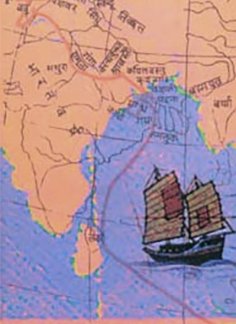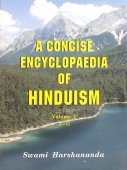Panduranga, Pāṇḍuraṅga, Pandu-ranga, Pamduramga: 9 definitions
Introduction:
Panduranga means something in Hinduism, Sanskrit, the history of ancient India, Jainism, Prakrit. If you want to know the exact meaning, history, etymology or English translation of this term then check out the descriptions on this page. Add your comment or reference to a book if you want to contribute to this summary article.
India history and geography
Source: Shodhganga: a concise history of Sanskrit Chanda literature (history)Pāṇḍuraṅga (पाण्डुरङ्ग) is the name of the son of Bhāskararāya (C. 1685-1775 C.E.) and his wife Ānandī. Bhāskararāya was a polymath of 18th century and the son of Gambhīrarāya Bhāratī and Konamāmbā of Viśvāmitragotra and younger brother of Sakhārāma. Bhāskararāya married to Ānandī, who afterward became famous in the name of Padmāvatyambikā and by their union a boy namely Pāṇḍuraṅga took birth. He also married another lady namely Pārvatī during his tour to Gujarat. He migrated to the banks of Krishna river from Benares. Towards the end of his life, he resided at Bhāskararājapuram (on the banks of river Kāverī), gifted to him by the Maratha ruler of Thanjavur.

The history of India traces the identification of countries, villages, towns and other regions of India, as well as mythology, zoology, royal dynasties, rulers, tribes, local festivities and traditions and regional languages. Ancient India enjoyed religious freedom and encourages the path of Dharma, a concept common to Buddhism, Hinduism, and Jainism.
Languages of India and abroad
Sanskrit dictionary
Source: DDSA: The practical Sanskrit-English dictionaryPāṇḍuraṅga (पाण्डुरङ्ग).—Name of a god (at Pandharpur), Viṭṭhala.
Derivable forms: pāṇḍuraṅgaḥ (पाण्डुरङ्गः).
Pāṇḍuraṅga is a Sanskrit compound consisting of the terms pāṇḍu and raṅga (रङ्ग).
Source: Cologne Digital Sanskrit Dictionaries: Aufrecht Catalogus Catalogorum1) Pāṇḍuraṅga (पाण्डुरङ्ग) as mentioned in Aufrecht’s Catalogus Catalogorum:—Pañcaratnaprakāśa.
2) Pāṇḍuraṅga (पाण्डुरङ्ग):—Viṣṇutātparyanirṇaya, a
—[commentary] on Ānandatīrtha’s Viṣṇutattvanirṇaya. Burnell. 106^b. Compare Pāṇḍuraṅgīya, vedānta. Oppert. Ii, 156.
3) Pāṇḍuraṅga (पाण्डुरङ्ग):—of the Atrigotra, father of Rāmacandra (Śivapūjāsūtravyākhyāna).
4) Pāṇḍuraṅga (पाण्डुरङ्ग):—son of Nārāyaṇa: Advaitajalajāta.
Source: Cologne Digital Sanskrit Dictionaries: Monier-Williams Sanskrit-English Dictionary1) Pāṇḍuraṅga (पाण्डुरङ्ग):—[=pāṇḍu-raṅga] [from pāṇḍu] m. a kind of vegetable, [cf. Lexicographers, esp. such as amarasiṃha, halāyudha, hemacandra, etc.]
2) [v.s. ...] Name of sub voce authors, [Catalogue(s)]
3) Pāṇḍuraṅgā (पाण्डुरङ्गा):—[=pāṇḍu-raṅgā] [from pāṇḍu-raṅga > pāṇḍu] f. Name of a goddess (?), [ib.]
Source: DDSA: Paia-sadda-mahannavo; a comprehensive Prakrit Hindi dictionary (S)Pāṇḍurāṅga (पाण्डुराङ्ग) in the Sanskrit language is related to the Prakrit word: Paṃḍuraṃga.
[Sanskrit to German]
Sanskrit, also spelled संस्कृतम् (saṃskṛtam), is an ancient language of India commonly seen as the grandmother of the Indo-European language family (even English!). Closely allied with Prakrit and Pali, Sanskrit is more exhaustive in both grammar and terms and has the most extensive collection of literature in the world, greatly surpassing its sister-languages Greek and Latin.
Prakrit-English dictionary
Source: DDSA: Paia-sadda-mahannavo; a comprehensive Prakrit Hindi dictionaryPaṃḍuraṃga (पंडुरंग) in the Prakrit language is related to the Sanskrit word: Pāṇḍurāṅga.
Prakrit is an ancient language closely associated with both Pali and Sanskrit. Jain literature is often composed in this language or sub-dialects, such as the Agamas and their commentaries which are written in Ardhamagadhi and Maharashtri Prakrit. The earliest extant texts can be dated to as early as the 4th century BCE although core portions might be older.
Kannada-English dictionary
Source: Alar: Kannada-English corpusPāṃḍuraṃga (ಪಾಂಡುರಂಗ):—
1) [noun] a man of white complexion.
2) [noun] Śiva.
--- OR ---
Pāṃḍuraṃga (ಪಾಂಡುರಂಗ):—[noun] a form of the Viṣṇu; also known as Pāṇḍuraṃga Viṭṭhala, the most loved deity of many Haridāsas of Karnāṭaka.
Kannada is a Dravidian language (as opposed to the Indo-European language family) mainly spoken in the southwestern region of India.
See also (Relevant definitions)
Partial matches: Ranga, Pandu, Pantu.
Starts with: Pamduramgavitthala, Pandurangamahatmya, Pandurangashtaka, Pandurangavilasacampu, Pandurangavilasachampu, Pandurangavitthalastotra.
Full-text (+4): Pandurangamahatmya, Pandurangavitthalastotra, Pandurangashtaka, Pamduramgavitthala, Kedhavam, Advaitajalajata, Pancaratnaprakasha, Avirbhavanem, Pandarabhikshu, Shivapujasutravyakhyana, Osanga, Jhani, Aivaja, Tanamana, Kavasha, Suranga, Anandi, Padmavatyambika, Vishnutattvanirnaya, Bhaskararajapuram.
Relevant text
Search found 11 books and stories containing Panduranga, Pāṇḍuraṅga, Pandu-ranga, Pāṇḍu-raṅga, Pāṇḍuraṅgā, Pāṇḍu-raṅgā, Pamduramga, Paṃḍuraṃga, Paṇḍuraṅga, Pāṇḍurāṅga, Pāṃḍuraṃga; (plurals include: Pandurangas, Pāṇḍuraṅgas, rangas, raṅgas, Pāṇḍuraṅgās, raṅgās, Pamduramgas, Paṃḍuraṃgas, Paṇḍuraṅgas, Pāṇḍurāṅgas, Pāṃḍuraṃgas). You can also click to the full overview containing English textual excerpts. Below are direct links for the most relevant articles:
Vietnamese Buddhist Art (by Nguyen Ngoc Vinh)
1. History of Champa < [Chapter 2 - Similarity of Buddhist monuments in South Vietnam and South East Asia]
1. Sculptures in Champa < [Chapter 4 - The Sculpture and its Reciprocal Influence]
2a. The Spread of Buddhism < [Chapter 1 - The evolution of Buddhist Art in South Vietnam and South East Asia]
Dvisahasri of Tembesvami (Summary and Study) (by Upadhyay Mihirkumar Sudhirbhai)
The saints and the Monks of Dattātreya Cult < [Introduction]
A History of Indian Philosophy Volume 4 (by Surendranath Dasgupta)
Part 8 - Life of Vallabha (1481-1533) < [Chapter XXXI - The Philosophy of Vallabha]
Part 3 - Important Madhva Works < [Chapter XXV - Madhva and his School]
Vastu-shastra (5): Temple Architecture (by D. N. Shukla)
Vijayanagara Style (1350—1565 A.D.) < [Chapter 12 - History of Hindu Temples (Prāsādas and Vimānas)]
Namasmarana - A Universal Sadhana (by Narayana Kasturi)
Related products
